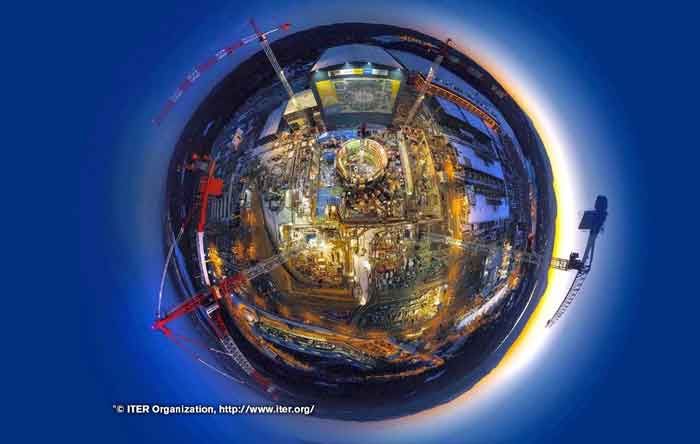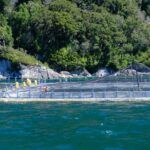Why fusion?
By Robert J. Goldston | April 9, 2018
 Aerial view of ITER construction at night, taken with an ultra wide-angle "fisheye" lens. Copyright ITER Organization.
Aerial view of ITER construction at night, taken with an ultra wide-angle "fisheye" lens. Copyright ITER Organization.
Energy is a key driver for human development. The industrial revolution of the 19th century was made possible by coal and steam. The leap in human capabilities in the 20th century was supported by an abundance of fossil fuels and by electrification. As we enter the 21st century, our energy systems have grown to the scale where they are affecting the global environment. By our actions—and our inactions—we will determine what energy sources will drive human development in the future. We need to be clear-eyed as we view the alternatives, and we need to consider them at the very large scale that will be needed.
The 2014 Intergovernmental Panel on Climate Change (IPCC) Fifth Assessment Report included publication on the web of a wide range of scenarios for the future, produced by energy and environment modelers from all over the world. If we select the internationally coordinated set of scenarios that are consistent with a temperature rise of less than 2 degrees Celsius (3.6 degrees Fahrenheit) above the pre-industrial era—the upper-limit goal of the Paris Climate Accords—and average their projections, we find the projection for future electricity production in the table below, shown in units of annually averaged gigawatts electrical <GWe>. (An alternative set of analyses, known as AMPERE 2, gives very similar results.)
IPCC Projected Worldwide Annually Averaged Electrical Power Production <GWe>
|
|
2020 |
2050 |
2100 |
|
Solar |
30 |
650 |
3720 |
|
Nuclear |
400 |
1120 |
2230 |
|
Wind |
150 |
930 |
2170 |
|
Biomass |
40 |
540 |
1500 |
|
Hydro |
410 |
640 |
850 |
|
Coal + Oil |
920 |
860 |
770 |
|
Gas |
780 |
980 |
620 |
|
Geothermal |
30 |
84 |
100 |
|
Total |
2770 |
5800 |
11900 |
This IPCC-based mean scenario relies heavily on solar and wind, which vary strongly on a daily and seasonal basis. By the time these intermittent energy sources become dominant, later in the century, we may well have developed the capability to mitigate their daily variation using energy storage. Seasonal variation, however, is hundreds of times harder to compensate, and it is difficult to imagine how this can be done effectively. As solar and wind grow in scale they will need to occupy sites with higher variability, and when they become a large fraction of the energy supply, later in the century, the costs associated with their variability will grow.
The IPCC scenario also relies heavily on nuclear fission power, which carries with it well-known risks associated with safety, waste storage, and nuclear weapons proliferation. By later in the century, this scenario burns all of the world’s reported identified, predicted, and speculative uranium resources. While other resources may become available, the scale of this uranium use, coupled with its uneven distribution, is likely to cause growth in the use of reprocessing technology and plutonium fuel, significantly increasing proliferation risks. Another concern is the implied requirement for geological waste storage in the absence of reprocessing, expected to be about 50 facilities with the capacity of Yucca Mountain.
Biomass, while somewhat smaller than the others listed above it, is equally important because it is assumed to provide a net sink of carbon dioxide. Vegetation extracts carbon from the atmosphere as it grows, and if much of the CO2 produced from its combustion can be captured and stored, then the overall system forms a net sink. The biomass in the IPCC scenario, however, requires using land equal to about 75 percent of all the land that is currently employed by agriculture, at a time when world food consumption is projected to more than double and the competition for water grows. The very large scale of the biomass CO2 that would need to be sequestered from the environment—for hundreds of years, in varying geological conditions—is far beyond our experience. The possibility of burning coal, oil, and gas into the future also depends on carbon capture and storage on a massive scale, in a broad range of geologies.
Consequently, solar and wind have a common limitation in most parts of the globe: seasonal variability.
Meanwhile, biomass, coal, oil, and gas share a common risk—the practicality of very large-scale carbon storage worldwide. And nuclear fission introduces risks associated with safety, radioactive waste, and nuclear proliferation. These energy sources all need to be pursued vigorously to determine the degree to which their limitations, risks, and problems can be overcome at the unprecedented scale required.
In contrast, fusion energy can offer an attractive alternative. Fusion is a continuous energy source; it does not face the same safety, waste, and proliferation issues as fission; it does not require disproportionate land use; and it does not depend on the success of carbon capture and storage. Fusion can come on line later in the century, as electric power needs double between 2050 and 2100, and as the scale of electricity production puts strong pressure on the issues for other energy sources.
What sets the timescale for fusion development? Until recently, the answer has been the science. The very hot gas, called plasma, that supports fusion is tricky, and it has taken time for scientists to understand its behavior. In that time we have made immense strides. We are now able to accurately calculate, predict, and control key aspects of the behavior of fusion plasmas. We know how to heat plasmas to fusion temperature, we know how plasmas confine the heat put into them, and we know how the heat flows out. We also know how the precious tritium that is used to fuel a fusion power system circulates, and we have demonstrated that fusion devices with metallic walls retain very little of it. There is room for innovation and improvement, but the basic outlines of how a fusion power system can work are now well-known. We have already made plasmas where we pour in 25 million watts of heating power, and an additional 16 millions watts of heat from fusion pours out. An international coalition comprised of China, Europe, India, Japan, Russia, South Korea, and the United States is building the ITER project in southern France, whose goal is to produce 500 million watts of fusion heat, ten times its input of only 50 million watts of heating power. For a practical fusion power system, this ratio needs to be increased from 10 to about 25, due to the inefficiencies of turning electricity into plasma heating, and then fusion heat into electricity. That step is left for the first fusion pilot plants to follow ITER.
It is fair to ask, why can’t we have fusion sooner? The answer is that these systems are intrinsically large; you cannot test the physics and technology of fusion on a lab bench and then mass-produce fusion systems, as you can solar cells. Consequently, as we are now approaching systems on the scale of power plants, they are large, first-of-a-kind facilities, and they take time to construct. The only way that we have been able to assemble the financial resources to construct the ITER project is through international collaboration. But after ITER, the next facilities will likely be national fusion pilot plants, which will use the physics and technology developed from ITER to put net electricity onto the grid (subtracting out the energy required to operate the plant). China, Europe, and South Korea each have well-developed plans to do this. The United States should as well. Such plans put fusion on the path to supporting the continuing growth in world electricity supply as it is needed.
One author has questioned in these pages whether fusion can be an attractive energy source. Of course fusion will not be magical, but the questions raised by Daniel Jassby have answers. Fusion will require cooling like any heat-based energy source such as biomass, coal, and fission. Furthermore, fusion systems will use a fraction of their own energy production to sustain their operation—like any energy system equipped with carbon capture and storage, which uses a significant fraction of its power production to operate the capture and storage technologies. Some fusion power plant designs use liquid lead as a coolant, which is much more efficient than water and steam, and so requires reduced cooling to produce a given amount of electricity.
Fusion neutrons will surely damage the internal components closest to the plasma. In the first fusion pilot plants, materials in the regions with the highest neutron flux would need to be replaced every 6-to-12 months of full-power operation. There are options for new nano-structured materials that are more neutron-resistant. These can be developed and qualified for fusion application using computer simulations and small-scale tests, as well as tests in the pilot plants themselves and in follow-on fusion power sources, as was done for fission. Fusion will have nuclear waste, but the lifetime of this waste will be measured in decades, not millennia. Fusion neutrons can in principle be used to breed fuel for weapons. But because no breeding materials should be present in a fusion power plant, this will be much more straightforward to detect and deter, as compared with fission reactors where the production of large quantities of weapons-usable material is intrinsic to the process.
The first fusion power plants will be expensive, but one can expect that as the technology matures, costs will come down. The major safety issues that have driven up the cost of fission power plants over time are not present for fusion. In sum, while fusion energy is not magical, it has the potential to be an attractive energy source that can be deployed as major pressures rise on existing energy supply options.
It is encouraging that a number of start-up companies are now investing in fusion. They are looking for breakthrough paths to fusion energy, and every breakthrough—scientific or technological—is welcome, not to mention the contributions possible from the breadth of scientific enquiry they support. It is not very likely, however, that these small, high-risk private ventures will come to fruition before the work of the world’s large, open scientific research community. Venture capital firms generally make their profits by supporting multiple high payoff, but low probability, undertakings. Even so, the recently announced initiative by a private company associated with the Massachusetts Institute of Technology is potentially very helpful as it may open a path to reducing the size of fusion energy systems following on ITER’s results, through more advanced magnet technology based on new high-temperature superconductors.
So, what is the answer to “Why fusion?” The choice of the energy sources that will power human development throughout this century is extraordinarily important. And the cost of developing fusion is tiny compared to the size of the world’s energy economy. It is indeed far smaller than the subsidies provided by governments for existing energy sources. Fusion should be developed as a practical and attractive alternative, to become available at scale as other energy sources face major limitations, risks, and problems that may constrain their growth. We owe our children and grandchildren both the opportunity for further human development based on access to energy, and also the same lovely, green planet we inherited from our parents and grandparents.
Editor’s note: A year ago, the Bulletin published an article about the drawbacks of fusion as an energy source,“Fusion reactors—Not what they’re cracked up to be,” written by a physicist who had spent 25 years at the Princeton Plasma Physics Lab studying plasma physics and neutron production related to fusion energy research and development. The article garnered more than 100 reader comments and stirred up intense debate—so much so, that we asked the author, Daniel Jassby, to revisit the topic a few weeks ago, in “ITER is a showcase… for the drawbacks of fusion energy.”
Together, we make the world safer.
The Bulletin elevates expert voices above the noise. But as an independent nonprofit organization, our operations depend on the support of readers like you. Help us continue to deliver quality journalism that holds leaders accountable. Your support of our work at any level is important. In return, we promise our coverage will be understandable, influential, vigilant, solution-oriented, and fair-minded. Together we can make a difference.
Keywords: Nuclear Fusion Energy
Topics: Analysis, Fusion Energy
















To address reader requests, the Bulletin has assembled in one place a “greatest hits” collection of some of our articles on fusion energy, which date back decades. You can find it at https://thebulletin.org/2019/04/fusions-greatest-hits-as-detailed-in-the-bulletin/
very interesting stuff, this is like the argument to colonize Mars!!……why? the drawbacks are huge at this time, and the solutions are few. this is nothing but a research project at this point, getting to a output of 25X of input power…will be a massive challenge, as will using D+T as the initiator….other fusion modalities must also be investigated….